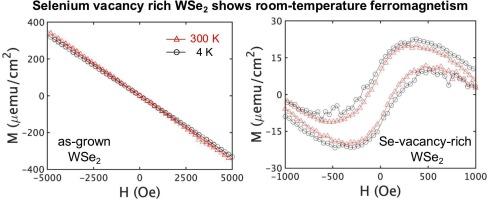Room-temperature ferromagnetism in monolayer WSe2
IF 22
1区 材料科学
Q1 MATERIALS SCIENCE, MULTIDISCIPLINARY
引用次数: 0
Abstract
Substitutional doping of magnetic impurities in monolayer transition metal dichalcogenides is a potentially promising route to create above room temperature 2D ferromagnets. Recent reports, however, reveal significant inconsistencies between multiple experimental observations and theoretical calculations. To unravel these apparent discrepancies, a comprehensive study is performed. It is found that while magnetic dopants (V and Fe) substitutionally replace the W for concentrations up to 35 %, no ferromagnetism is observed in these doped WSe2 monolayers with minimal point defects. The suppression of the theoretically predicted ferromagnetic order at these doping levels is due to clustering of the dopants which is observed and quantified from plan-view transmission electron microscopy. Room-temperature ferromagnetism is observed when the doped monolayers contain a significant concentration of selenium vacancies (Sevac). These vacancies were intentionally created via a post-growth annealing process and magnetism is seen to scale with annealing time/vacancy concentration. In fact, very similar ferromagnetism is seen even in undoped WSe2 with Sevac > 1014 cm−2 suggesting an easier potential route to synthesize room-temperature 2D ferromagnets compared to metal substitution. These findings can explain all the discrepancies in the literature and suggest that no room-temperature ferromagnetism in WSe2 has been reported that was not caused by high levels of Se vacancies.

单层WSe2的室温铁磁性
在单层过渡金属二硫族化物中取代掺杂磁性杂质是制备室温以上二维铁磁体的一种有潜力的途径。然而,最近的报告揭示了多个实验观察和理论计算之间的重大不一致。为了揭示这些明显的差异,进行了一项全面的研究。研究发现,当磁性掺杂剂(V和Fe)取代浓度高达35%的W时,这些掺杂的WSe2单层中没有观察到铁磁性,并且具有最小的点缺陷。在这些掺杂水平下,理论预测的铁磁有序的抑制是由于从平面透射电镜观察和量化的掺杂的聚类。当掺杂的单层含有显著浓度的硒空位(Sevac)时,可以观察到室温铁磁性。这些空位是通过生长后退火工艺有意产生的,磁性随退火时间/空位浓度而成比例。事实上,即使在未掺杂Sevac的WSe2中也可以看到非常相似的铁磁性。与金属取代相比,这是一种更容易合成室温二维铁磁体的潜在途径。这些发现可以解释文献中的所有差异,并表明WSe2中没有一种室温铁磁性不是由高水平的Se空位引起的。
本文章由计算机程序翻译,如有差异,请以英文原文为准。
求助全文
约1分钟内获得全文
求助全文
来源期刊

Materials Today
工程技术-材料科学:综合
CiteScore
36.30
自引率
1.20%
发文量
237
审稿时长
23 days
期刊介绍:
Materials Today is the leading journal in the Materials Today family, focusing on the latest and most impactful work in the materials science community. With a reputation for excellence in news and reviews, the journal has now expanded its coverage to include original research and aims to be at the forefront of the field.
We welcome comprehensive articles, short communications, and review articles from established leaders in the rapidly evolving fields of materials science and related disciplines. We strive to provide authors with rigorous peer review, fast publication, and maximum exposure for their work. While we only accept the most significant manuscripts, our speedy evaluation process ensures that there are no unnecessary publication delays.
 求助内容:
求助内容: 应助结果提醒方式:
应助结果提醒方式:


